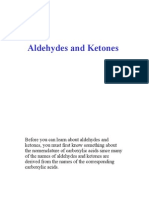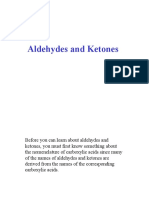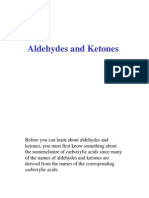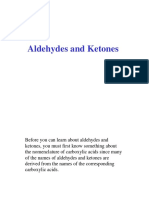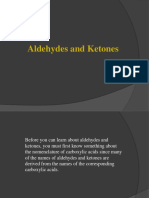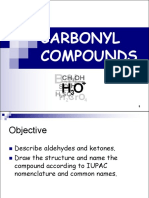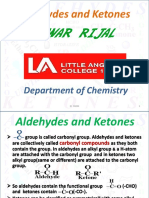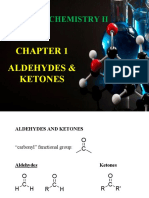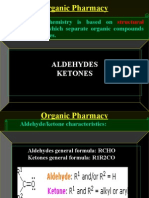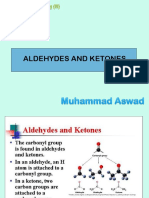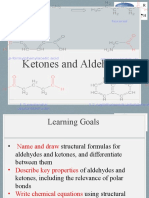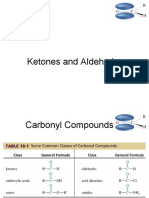Ald&Ketone I
Ald&Ketone I
Uploaded by
Abhay NarvekarCopyright:
Available Formats
Ald&Ketone I
Ald&Ketone I
Uploaded by
Abhay NarvekarOriginal Description:
Original Title
Copyright
Available Formats
Share this document
Did you find this document useful?
Is this content inappropriate?
Copyright:
Available Formats
Ald&Ketone I
Ald&Ketone I
Uploaded by
Abhay NarvekarCopyright:
Available Formats
Aldehydes and Ketones
Before you can learn about aldehydes and
ketones, you must first know something about
the nomenclature of carboxylic acids since many
of the names of aldehydes and ketones are
derived from the names of the corresponding
carboxylic acids.
Carboxylic acids:
R-COOH, R-CO
2
H,
Common names:
HCO
2
H formic acid L. formica ant
CH
3
CO
2
H acetic acid L. acetum vinegar
CH
3
CH
2
CO
2
H propionic acid G. first salt
CH
3
CH
2
CH
2
CO
2
H butyric acid L. butyrum butter
CH
3
CH
2
CH
2
CH
2
CO
2
H valeric acid L. valerans
R C
OH
O
Carboxylic acids, common names:
CH
3
(CH
2
)
4
CO
2
H caproic acid L. caper goat
CH
3
(CH
2
)
5
CO
2
H ---
CH
3
(CH
2
)
6
CO
2
H caprylic acid
CH
3
(CH
2
)
7
CO
2
H ---
CH
3
(CH
2
)
8
CO
2
H capric acid
CH
3
(CH
2
)
9
CO
2
H ---
CH
3
(CH
2
)
10
CO
2
H lauric acid oil of lauryl
5 4 3 2 1
CCCCC=O
used in common names
CH
3
CH
2
CH
2
CHCOOH
Br
CH
3
CHCH
2
COOH
CH
3
bromovaleric acid -methylbutyric acid
isovaleric acid
COOH
COOH COOH
COOH
CH
3
CH
3
CH
3
benzoic acid
o-toluic acid m-toluic acid p-toluic acid
Special names!
ALDEHYDES AND KETONES
carbonyl functional group:
Aldehydes Ketones
H
C
H
O
R
C
H
O
R
C
R'
O
R can be Ar
C
O
Nomenclature:
Aldehydes, common names:
Derived from the common names of carboxylic acids;
drop ic acid suffix and add aldehyde.
CH
3
CH
3
CH
2
CH
2
CH=O CH
3
CHCH=O
butyraldehyde isobutyraldehyde
(-methylpropionaldehyde)
CHO
benzaldehyde
CHO
CH
3
o-tolualdehyde
H
C
H
O
formaldehyde
CH
2
CH=O
phenylacetaldehyde
Aldehydes, IUPAC nomenclature:
Parent chain = longest continuous carbon chain containing
the carbonyl group; alkane, drop e, add al. (note: no
locant, -CH=O is carbon #1.)
CH
3
CH
3
CH
2
CH
2
CH=O CH
3
CHCH=O
butanal 2-methylpropanal
H
2
C=O CH
3
CH=O
methanal ethanal
Ketones, common names:
Special name: acetone
alkyl alkyl ketone or dialkyl ketone
H
3
C
C
CH
3
O
CH
3
CH
2
CCH
3
O
CH
3
CH
2
CCH
2
CH
3
O
ethyl methyl ketone diethyl ketone
CH
3
CCH
2
CH
2
CH
3
O
methyl n-propyl ketone
(o)phenones:
Derived from common name of carboxylic acid, drop ic
acid, add (o)phenone.
C R
O
C
O
H
3
C
C
O
benzophenone
acetophenone
Ketones: IUPAC nomenclature:
Parent = longest continuous carbon chain containing the
carbonyl group. Alkane, drop e, add one. Prefix a locant
for the position of the carbonyl using the principle of lower
number.
CH
3
CH
2
CCH
3
O
CH
3
CH
2
CCH
2
CH
3
O
2-butanone
3-pentanone
CH
3
CCH
2
CH
2
CH
3
O
2-pentanone
Physical properties:
polar, no hydrogen bonding
mp/bp are relatively moderate for covalent substances
water insoluble
(except: four-carbons or less)
C O
sp
2
120
o
C O C O
Spectroscopy:
IR: C=O stretch, strong ~1700 cm
-1
RCHO 1725 ArCHO 1700
R
2
CO 1710 ArCOR 1690
CH stretch for aldehydes 2720
nmr: -CHO 9-10 ppm
C=O
stretch
acetophenone
valeraldehyde
CHO
CH
stretch
2720 cm
-1
C=O stretch
valeraldehyde
CH
3
CH
2
CH
2
CH
2
CH=O
a b c d e
-CHO
Oxidation/Reduction:
oxidation numbers:
oxidation
-4 -2 0 +2 +4
CH
4
CH
3
OH H
2
C=O HCO
2
H CO
2
alkane alcohol aldehyde carboxylic acid
reduction
Aldehydes, syntheses:
1. Oxidation of 1
o
alcohols
2. Oxidation of methylaromatics
3. Reduction of acid chlorides
Ketones, syntheses:
1. Oxidation of 2
o
alcohols
2. Friedel-Crafts acylation
3. Coupling of R
2
CuLi with acid chloride
Aldehydes synthesis 1) oxidation of primary alcohols:
RCH
2
-OH + K
2
Cr
2
O
7
, special conditions RCH=O
RCH
2
-OH + C
5
H
5
NHCrO
3
Cl RCH=O
(pyridinium chlorochromate)
[With other oxidizing agents, primary alcohols RCOOH]
CH
3
CH
2
CH
2
CH
2
CH
2
OH
+ K
2
Cr
2
O
7
CH
3
CH
2
CH
2
CH
2
CO
2
H
1-pentanol
pentanoic acid
K
2
Cr
2
O
7
, special conditions!
CH
3
CH
2
CH
2
CH
2
CH=O
pentanal
valeraldehyde
CH
2
OH
C
5
H
5
NHCrO
3
Cl
pyridinium chlorochromate
CH=O
benzaldehyde
benzyl alcohol
CH
3
CH
2
CH
2
CH
2
CH
2
OH
1-pentanol
Aldehyde synthesis: 2) oxidation of methylaromatics:
+ CrO
3
, (CH
3
CO)
2
O
geminal diacetate
H
2
O, H
+
CH
3
Br
Br
CH O
O C C
H
3
C
O
O
H
3
C
Br
CHO
p-bromobenzaldehyde
Aromatic aldehydes only!
CH
3
CH
3
O CH
3
CrO
3
(CH
3
CO)
2
O
CrO
3
(CH
3
CO)
2
O
H
2
O
H
2
O
CHO
CH
3
O CH=O
2-methylnaphthalene 2-naphthaldehyde
p-methylanisole
p-anisaldehyde
Aldehyde synthesis: 3) reduction of acid chloride
LiAlH(O-t-Bu)
3
lithium aluminum hydride tri-tert-butoxide
O
Cl
isovaleryl chloride
O
H
isovaleraldehyde
R
C
O
Cl
LiAlH(O-t-Bu)
3
R
C
O
H
C
O
Cl
LiAlH(O-t-Bu)
3
C
O
H
LiAlH(O-t-Bu)
3
benzoyl chloride
benzaldehyde
CH
3
CHCH
2
C
O
Cl
CH
3
CH
3
CHCH
2
C
O
H
CH
3
isovaleryl chloride
isovaleraldehyde
Ketone synthesis: 1) oxidation of secondary alcohols
NaOCl
cyclohexanol
cyclohexanone
isopropyl alcohol
acetone
K
2
Cr
2
O
7
H OH
O
H
3
C
C
CH
3
O
CH
3
CHCH
3
OH
Ketone synthesis: 2) Friedel-Crafts acylation
RCOCl, AlCl
3
+ ArH + HCl
AlCl
3
Ar C R
O
Aromatic ketones (phenones) only!
CH
3
CH
2
CH
2
C
O
Cl
+
AlCl
3
CH
3
CH
2
CH
2
C
O
butyrophenone
+
AlCl
3
m-nitrobenzophenone
O
2
N
C Cl
O
C
O
O
2
N
+
AlCl
3
C Cl
O
NO
2
NR
Friedel Crafts acylation does not work on deactivated rings.
Mechanism for Friedel-Crafts acylation EAS
R
C
Cl
O
+ AlCl
3 RC=O + AlCl
4
+ RC=O
RDS
H
CR
O
H
CR
O
+ AlCl
4
C R
O
+ HCl + AlCl
3
Ketone synthesis: 3) coupling of RCOCl and R
2
CuLi
RCOCl + R'
2
CuLi
R
C
O
R'
Cl
O
+
(CH
3
CH
2
)
2
CuLi
O
Isobutyryl chloride
2-Methyl-3-pentanone
lithium diethylcuprate
CuLi
2
+ CHCH
2
CH
2
CH
3
O
Cl
CCH
2
CH
2
CH
3
O
butyrophenone
CH
3
CH
2
CH
2
C
O
Cl
+
CH
3
CH
CH
3
2
CuLi CH
3
CH
2
CH
2
CCHCH
3
O
CH
3
2-methyl-3-hexanone
Aldehydes, syntheses:
1. Oxidation of 1
o
alcohols
2. Oxidation of methylaromatics aromatic only
3. Reduction of acid chlorides
Ketones, syntheses:
1. Oxidation of 2
o
alcohols
2. Friedel-Crafts acylation aromatic only
3. Coupling of R
2
CuLi with acid chloride
aldehyde
1
o
alcohol
Ar-CH
3
acid chloride
CrO
3
H
2
O
(AcO)
2
O
LiAlH(O-t-Bu)
3
K
2
Cr
2
O
7
, special cond.
or C
5
H
5
NHCrO
3
Cl
ketone
2
o
alcohol
acid chloride + ArH
acid chloride + R
2
CuLi
NaOCl, etc.
AlCl
3
1. outline three different syntheses for benzaldehyde
2. outline three different syntheses for benzophenone
3. outline a different synthesis for each of the
following compounds:
cyclohexanone, 4-bromobenzaldehyde, 2-pentanone,
valeraldehyde, acetophenone, isobutyraldehyde,
CH
2
OH
K
2
Cr
2
O
7
special conditions
CH
3
CrO
3
(CH
3
CO)
2
O
CH(OOCCH
3
)
2
H
2
O
C
O
Cl
LiAlH(O-t-Bu)
3
CH=O
benzaldehyde
Synthesize benzaldehyde three different ways.
CH
OH
NaOCl
C
O
Cl
+
AlCl
3
C
O
Cl
+
CuLi
2
C
O
Synthesize benzophenone three different ways.
cyclohexanone, 4-bromobenzaldehyde, 2-pentanone,
valeraldehyde, acetophenone, isobutyraldehyde, using a
different method for each one.
O
Br CHO
CH
3
CH
2
CH
2
CCH
3
O
CH
3
CH
2
CH
2
CH
2
CHO
CH
3
C
O
CH
3
CHCHO
CH
3
oxidation of 2
o
alcohol
oxidation of Ar-CH
3
R
2
CuLi + R'COCl
Friedel-Crafts acylation
oxidation of 1
o
alcohol
reduction of acid chloride
O
CH
3
CH
2
CH
2
CCH
3
O
CH
3
C
O
OH
H
K
2
Cr
2
O
7
CH
3
C
Cl
O
+
AlCl
3
(CH
3
CH
2
CH
2
)CuLi +
CH
3
C
Cl
O
Br CHO
CH
3
CH
2
CH
2
CH
2
CHO
CH
3
CHCHO
CH
3
Br CH
3
CH
3
CH
2
CH
2
CH
2
CH
2
-OH
K
2
Cr
2
O
7
special conditions
CrO
3
(CH
3
CO)
2
O
H
2
O
CH
3
CHC
CH
3
O
Cl
LiAlH(O-t-bu)
3
The methods could be reversed for the last two syntheses.
You might also like
- Schaum's Easy Outline of Organic Chemistry, Second EditionFrom EverandSchaum's Easy Outline of Organic Chemistry, Second EditionRating: 3.5 out of 5 stars3.5/5 (2)
- Ald&ketone IDocument41 pagesAld&ketone Iasney2512No ratings yet
- Ald&Ketone IDocument41 pagesAld&Ketone IHarsha Y MNo ratings yet
- Ald&KetoneDocument41 pagesAld&KetoneFeng SpencerNo ratings yet
- 5 Aldehydes and Ketones-Structure and PreparationDocument41 pages5 Aldehydes and Ketones-Structure and PreparationKeshav JoshiNo ratings yet
- Aldehydes and KetonesDocument41 pagesAldehydes and KetonesJerome DimaanoNo ratings yet
- Aldehyde and KetonesDocument41 pagesAldehyde and KetonesJerome DimaanoNo ratings yet
- Aldehydes and KetonesDocument16 pagesAldehydes and Ketonesmonika.rani.fasvNo ratings yet
- Carbonyl Compounds Xi Xii Study MaterialsDocument171 pagesCarbonyl Compounds Xi Xii Study MaterialsCristiano Hamdiansyah SempadianNo ratings yet
- 1e Aldehyde & KetoneDocument48 pages1e Aldehyde & KetoneJonathan Wyatt100% (1)
- Aldehydes, Ketones, Carboxylic Acids: R-COH Aldehyde R-CO-R Ketone R-CoohDocument17 pagesAldehydes, Ketones, Carboxylic Acids: R-COH Aldehyde R-CO-R Ketone R-CoohMoshe Cohen'sNo ratings yet
- Ald&Ketone IDocument41 pagesAld&Ketone IreinitavanyNo ratings yet
- Matriculation Chemistry (Carbonyl Compound)Document50 pagesMatriculation Chemistry (Carbonyl Compound)ridwanNo ratings yet
- Aldehyde Ketone and Carboxylic AcidDocument81 pagesAldehyde Ketone and Carboxylic AcidHaylynn DeepshikaNo ratings yet
- Module-12 - Aldehydes and KetonesDocument10 pagesModule-12 - Aldehydes and KetonesJohn Rey BusimeNo ratings yet
- Carbonyl CompoundsDocument50 pagesCarbonyl CompoundsFariz SharudinNo ratings yet
- Alcohol Phenol & EtherDocument13 pagesAlcohol Phenol & EtherAbir DuttaNo ratings yet
- Aldehydes and Ketones: Ishwar RijalDocument40 pagesAldehydes and Ketones: Ishwar RijalPurnima RautNo ratings yet
- Aldehyde and KetoneDocument39 pagesAldehyde and KetoneCitra Siti PurnamaNo ratings yet
- R-Cooh, R-Co H,: À Ant À VinegarDocument43 pagesR-Cooh, R-Co H,: À Ant À VinegarArvin MarasiganNo ratings yet
- Part 2-Chapter 3Document52 pagesPart 2-Chapter 3Nguyen NhatNo ratings yet
- Carboxylic AcidDocument37 pagesCarboxylic Acidaman2611994_1920111580% (5)
- Chapter 1 - Aldehydes KetonesDocument51 pagesChapter 1 - Aldehydes KetonesSarathy Hari KumarNo ratings yet
- Carboxylic AcidsDocument41 pagesCarboxylic AcidsSazzad TanimNo ratings yet
- Alcohols, Organic ChemistryDocument32 pagesAlcohols, Organic Chemistryclassy43390% (1)
- Carboxylic AcidDocument33 pagesCarboxylic AcidRika Yulliyani RNo ratings yet
- Fundamental Organic Chemistry Lecture IIDocument45 pagesFundamental Organic Chemistry Lecture IIEnkuan AbiyuNo ratings yet
- AldehydesDocument21 pagesAldehydesNoor Farrah Wahida MuradNo ratings yet
- Lecture 5 - Aldehydes & KetonesDocument93 pagesLecture 5 - Aldehydes & KetonesQutaiba Ibrahim100% (1)
- Chapter 16Document87 pagesChapter 16Hafizszul FeyzulNo ratings yet
- Aldehydes, Ketones and Carboxylic AcidsDocument17 pagesAldehydes, Ketones and Carboxylic AcidsSohamNo ratings yet
- Organic Chemistry: Dr. Omar Mohammed YahyaDocument15 pagesOrganic Chemistry: Dr. Omar Mohammed YahyaCover SongsNo ratings yet
- Organic Chemistry: Dr. Omar Mohammed YahyaDocument15 pagesOrganic Chemistry: Dr. Omar Mohammed YahyaCover SongsNo ratings yet
- Kimia OrganikDocument94 pagesKimia Organikwafaul_athiyyahNo ratings yet
- Aldehydes Ketones: Structural TheoryDocument75 pagesAldehydes Ketones: Structural TheoryNasif Abdur RazzaqueNo ratings yet
- Carboxylic Acids:: R-Cooh, R-Co HDocument29 pagesCarboxylic Acids:: R-Cooh, R-Co HRao Wazim AkramNo ratings yet
- Oxygen Containing Organic CompoundsDocument44 pagesOxygen Containing Organic CompoundsKeishaNo ratings yet
- S16 & 17-Aldehydes and KetonesDocument82 pagesS16 & 17-Aldehydes and Ketonesfurahajoseph924No ratings yet
- CC One ShotDocument29 pagesCC One Shotbobbytext8904No ratings yet
- Aldehid Keton 08Document48 pagesAldehid Keton 08Priagung SetyawanNo ratings yet
- Aldehydes & Ketones: (Alkanals & Alkanones)Document41 pagesAldehydes & Ketones: (Alkanals & Alkanones)Hunain NadeemNo ratings yet
- Synthesis of Drug 22Document44 pagesSynthesis of Drug 22sdfsy sdvdsvNo ratings yet
- Aldehydes & Ketones (Additional)Document24 pagesAldehydes & Ketones (Additional)Michael Angelo FilomenoNo ratings yet
- Aldehyde, Ketone and AlcoholDocument44 pagesAldehyde, Ketone and Alcoholosamakhan8967No ratings yet
- Carboxylic AcidDocument21 pagesCarboxylic AcidShalsabila NHNo ratings yet
- 5) Aldehydes & KetonesDocument28 pages5) Aldehydes & KetonesfhdlakNo ratings yet
- Chapter 17: Alcohols and Phenols: Phenol (Aromatic Alcohol) Alcohol SPDocument18 pagesChapter 17: Alcohols and Phenols: Phenol (Aromatic Alcohol) Alcohol SPKriti Tyagi100% (2)
- Aldehydes and Ketones - Notes-12Document11 pagesAldehydes and Ketones - Notes-12Shashank ParthibanNo ratings yet
- ch-20. Carboxylic AcidsDocument24 pagesch-20. Carboxylic Acidszjan1122112No ratings yet
- AlcoholsDocument91 pagesAlcoholsWAN NUR AISYAH WAN AZIZANNo ratings yet
- Org. Chem. (Chapter 8)Document25 pagesOrg. Chem. (Chapter 8)Jia LinNo ratings yet
- Chapter 7Document30 pagesChapter 7c4.arsyadNo ratings yet
- 4A Ketones and AldehydesDocument28 pages4A Ketones and AldehydesAnloraine GonzalesNo ratings yet
- Aldehydes and Ketones-DSVOLDocument107 pagesAldehydes and Ketones-DSVOLMERCY ATUYANo ratings yet
- Org. Chem. (Chapter 8)Document25 pagesOrg. Chem. (Chapter 8)Jia LinNo ratings yet
- Carboxylic Acid Jeemain - GuruDocument26 pagesCarboxylic Acid Jeemain - GuruKumar KumarNo ratings yet
- CH 16Document102 pagesCH 16Amer KhanNo ratings yet
- Jee-Aldehyde Ketone & Carboxylic Acid Chem XiiDocument72 pagesJee-Aldehyde Ketone & Carboxylic Acid Chem Xiiswastik aroraNo ratings yet
- Synergy Atomized Aluminium PowderDocument1 pageSynergy Atomized Aluminium PowderAbhay NarvekarNo ratings yet
- Synergy Aluminium GranulesDocument1 pageSynergy Aluminium GranulesAbhay NarvekarNo ratings yet
- Maintenance Up To 1st January 2012Document3 pagesMaintenance Up To 1st January 2012Abhay NarvekarNo ratings yet
- Block ProductionDocument2 pagesBlock ProductionAbhay NarvekarNo ratings yet
- Organic or InorganicDocument12 pagesOrganic or InorganicINDIRAKALYANINo ratings yet
- Nitrogen Family CDFDocument3 pagesNitrogen Family CDFudayNo ratings yet
- Q4 ScienceDocument4 pagesQ4 ScienceVince Laurence BlancaflorNo ratings yet
- Chapter 1 - Aldehydes KetonesDocument51 pagesChapter 1 - Aldehydes KetonesSarathy Hari KumarNo ratings yet
- 12th Chemistry Vol.1 Book Back One Mark Questions English Medium PDF DownloadDocument19 pages12th Chemistry Vol.1 Book Back One Mark Questions English Medium PDF Downloadteddygamingyt201No ratings yet
- Chapter 2 Form5Document9 pagesChapter 2 Form5Zulkifli Bin Pari100% (1)
- Silicone Resins PDFDocument12 pagesSilicone Resins PDFJulián Herrera RestrepoNo ratings yet
- Chem Paper1. MR Mbuya 'S TakeDocument15 pagesChem Paper1. MR Mbuya 'S Takecephuskinyua2No ratings yet
- Prelims HacksDocument1 pagePrelims HacksBEA FRANCINE DELOS SANTOSNo ratings yet
- DH AmakaDocument91 pagesDH AmakaazsaNo ratings yet
- 778 / 6-Methyl-5-Hepten-2-One / Monographs FCC 9Document40 pages778 / 6-Methyl-5-Hepten-2-One / Monographs FCC 9Willian SilvaNo ratings yet
- 5 6145477749600419914Document22 pages5 6145477749600419914Ihtisham Ul HaqNo ratings yet
- Chemistry NYA Notes and Exercises Part 1Document71 pagesChemistry NYA Notes and Exercises Part 1qwerty514No ratings yet
- CHEMISTRY (Code No. 043) (2022-2023) : ObjectivesDocument14 pagesCHEMISTRY (Code No. 043) (2022-2023) : ObjectivesJa SioNo ratings yet
- Sanitizer PostlabDocument4 pagesSanitizer PostlabapaulitikoNo ratings yet
- Plant Based Dyes and Mordant: A Review: NOVEMBER 2012Document17 pagesPlant Based Dyes and Mordant: A Review: NOVEMBER 2012SuriParkNo ratings yet
- Parafin 3Document1 pageParafin 3Andrianna NastasyaNo ratings yet
- Chemsheets A2 1025 Reactions of AromaticsDocument5 pagesChemsheets A2 1025 Reactions of Aromaticsxl:D cNo ratings yet
- End of Term 1 Physcis and Chemistry-2024Document14 pagesEnd of Term 1 Physcis and Chemistry-2024angellevitt520No ratings yet
- Review of Copper 2017.05.021Document194 pagesReview of Copper 2017.05.021chérifa boulechfarNo ratings yet
- Classroom Practice I: Amino Acids and Peptides Amino Acids, Peptides and Proteins QuestionsDocument2 pagesClassroom Practice I: Amino Acids and Peptides Amino Acids, Peptides and Proteins QuestionsValentina CretuNo ratings yet
- Daftar Harga Cat Foxapaint 2022: Pack Size (KG) Alkyd CoatingDocument1 pageDaftar Harga Cat Foxapaint 2022: Pack Size (KG) Alkyd CoatingEltama PrimaindoNo ratings yet
- 24.8.18 GctiDocument112 pages24.8.18 GctiReena SinghalNo ratings yet
- Reagent Chemicals ProcedureDocument9 pagesReagent Chemicals ProcedurejycortesNo ratings yet
- E-Content For Class X Science: Acids Bases and Salts (Chapter-2)Document31 pagesE-Content For Class X Science: Acids Bases and Salts (Chapter-2)Harshit GoelNo ratings yet
- Welding ShopDocument14 pagesWelding ShopGOBINDA KISANNo ratings yet
- Lab 3 Ibg 112 Wong Kar JinDocument9 pagesLab 3 Ibg 112 Wong Kar JinJimmy WongNo ratings yet
- HydrocarbonsDocument80 pagesHydrocarbonsina stanevaNo ratings yet
- Fundamentals of Petroleum and Petrochemical Engineering: Uttam Ray ChaudhuriDocument70 pagesFundamentals of Petroleum and Petrochemical Engineering: Uttam Ray ChaudhuriEmad AliNo ratings yet
- List of Available Analysis 2022Document10 pagesList of Available Analysis 2022oubaha happyNo ratings yet

